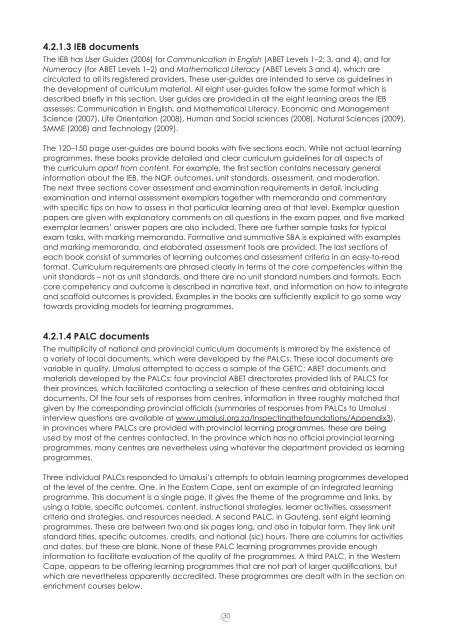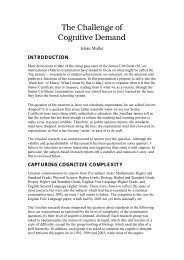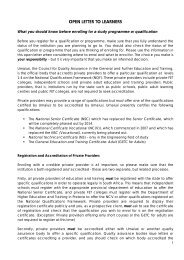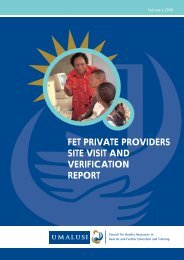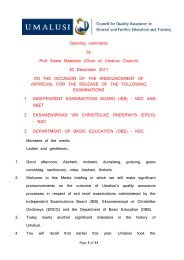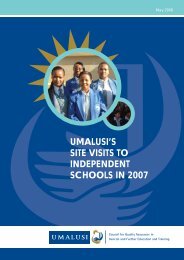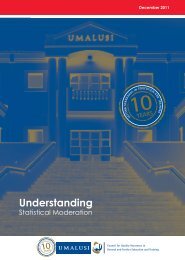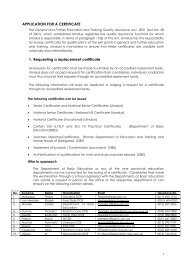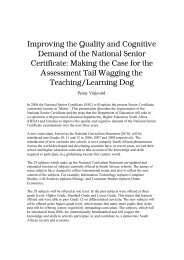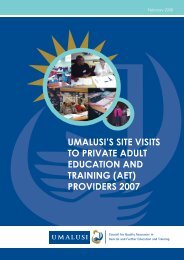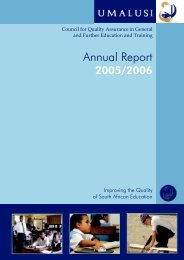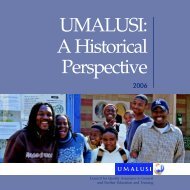Inspecting the Foundations - Umalusi
Inspecting the Foundations - Umalusi
Inspecting the Foundations - Umalusi
You also want an ePaper? Increase the reach of your titles
YUMPU automatically turns print PDFs into web optimized ePapers that Google loves.
4.2.1.3 IEB documentsThe IEB has User Guides (2006) for Communication in English (ABET Levels 1–2; 3, and 4), and forNumeracy (for ABET Levels 1–2) and Ma<strong>the</strong>matical Literacy (ABET Levels 3 and 4), which arecirculated to all its registered providers. These user-guides are intended to serve as guidelines in<strong>the</strong> development of curriculum material. All eight user-guides follow <strong>the</strong> same format which isdescribed briefl y in this section. User guides are provided in all <strong>the</strong> eight learning areas <strong>the</strong> IEBassesses: Communication in English, and Ma<strong>the</strong>matical Literacy, Economic and ManagementScience (2007), Life Orientation (2008), Human and Social sciences (2008), Natural Sciences (2009),SMME (2008) and Technology (2009).The 120–150 page user-guides are bound books with fi ve sections each. While not actual learningprogrammes, <strong>the</strong>se books provide detailed and clear curriculum guidelines for all aspects of<strong>the</strong> curriculum apart from content. For example, <strong>the</strong> fi rst section contains necessary generalinformation about <strong>the</strong> IEB, <strong>the</strong> NQF, outcomes, unit standards, assessment, and moderation.The next three sections cover assessment and examination requirements in detail, includingexamination and internal assessment exemplars toge<strong>the</strong>r with memoranda and commentarywith specifi c tips on how to assess in that particular learning area at that level. Exemplar questionpapers are given with explanatory comments on all questions in <strong>the</strong> exam paper, and fi ve markedexemplar learners’ answer papers are also included. There are fur<strong>the</strong>r sample tasks for typicalexam tasks, with marking memoranda. Formative and summative SBA is explained with examplesand marking memoranda, and elaborated assessment tools are provided. The last sections ofeach book consist of summaries of learning outcomes and assessment criteria in an easy-to-readformat. Curriculum requirements are phrased clearly in terms of <strong>the</strong> core competencies within <strong>the</strong>unit standards – not as unit standards, and <strong>the</strong>re are no unit standard numbers and formats. Eachcore competency and outcome is described in narrative text, and information on how to integrateand scaffold outcomes is provided. Examples in <strong>the</strong> books are suffi ciently explicit to go some waytowards providing models for learning programmes.4.2.1.4 PALC documentsThe multiplicity of national and provincial curriculum documents is mirrored by <strong>the</strong> existence ofa variety of local documents, which were developed by <strong>the</strong> PALCs. These local documents arevariable in quality. <strong>Umalusi</strong> attempted to access a sample of <strong>the</strong> GETC: ABET documents andmaterials developed by <strong>the</strong> PALCs: four provincial ABET directorates provided lists of PALCS for<strong>the</strong>ir provinces, which facilitated contacting a selection of <strong>the</strong>se centres and obtaining localdocuments. Of <strong>the</strong> four sets of responses from centres, information in three roughly matched thatgiven by <strong>the</strong> corresponding provincial offi cials (summaries of responses from PALCs to <strong>Umalusi</strong>interview questions are available at www.umalusi.org.za/<strong>Inspecting</strong><strong>the</strong>foundations/Appendix3).In provinces where PALCs are provided with provincial learning programmes, <strong>the</strong>se are beingused by most of <strong>the</strong> centres contacted. In <strong>the</strong> province which has no offi cial provincial learningprogrammes, many centres are never<strong>the</strong>less using whatever <strong>the</strong> department provided as learningprogrammes.Three individual PALCs responded to <strong>Umalusi</strong>’s attempts to obtain learning programmes developedat <strong>the</strong> level of <strong>the</strong> centre. One, in <strong>the</strong> Eastern Cape, sent an example of an integrated learningprogramme. This document is a single page. It gives <strong>the</strong> <strong>the</strong>me of <strong>the</strong> programme and links, byusing a table, specifi c outcomes, content, instructional strategies, learner activities, assessmentcriteria and strategies, and resources needed. A second PALC, in Gauteng, sent eight learningprogrammes. These are between two and six pages long, and also in tabular form. They link unitstandard titles, specifi c outcomes, credits, and national (sic) hours. There are columns for activitiesand dates, but <strong>the</strong>se are blank. None of <strong>the</strong>se PALC learning programmes provide enoughinformation to facilitate evaluation of <strong>the</strong> quality of <strong>the</strong> programmes. A third PALC, in <strong>the</strong> WesternCape, appears to be offering learning programmes that are not part of larger qualifi cations, butwhich are never<strong>the</strong>less apparently accredited. These programmes are dealt with in <strong>the</strong> section onenrichment courses below.30


